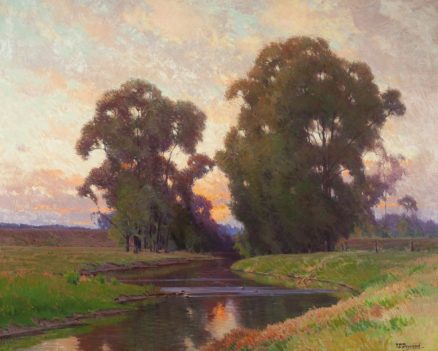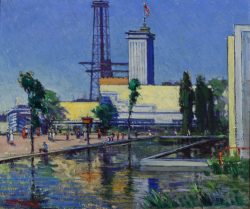- Categories
- Immigrant artists
- Landscapes
- Zoom in on Artwork
- Print Page
- Email Page to Friend
The focus of Frank C. Peyraud’s Summer Evening is a meandering stream that draws the eye from open meadows toward a dense stand of tall trees. Their height accentuated by the low viewpoint and horizon, the trees partly screen a brilliant sunset sky glimpsed in the center of the composition. The flat rural landscape is devoid of animate life, with fence posts in a line at the right the only hint of human activity. While Peyraud’s application of paint in short strokes of color qualified him as an impressionist among Chicago’s conservative art lovers, they simultaneously found reassurance in his solidly representational yet romantic portrayals. One critic lauded his works for their “virility tempered with tenderness.”i
In the late 1920s, his fifth decade as a landscape painter in Chicago, the aging Peyraud was still a prominent exhibiter locally and a regular prizewinner. Combining grandeur and simplicity in a generously sized canvas, Summer Evening seems designed to stand out in a crowded group exhibition. In 1927 Peyraud sent it to the fourth semi-annual members’ exhibition of the Chicago Galleries Association, where it won a purchase prize; it appeared in the Art Institute of Chicago’s “Chicago and Vicinity” annual exhibition the following winter and again in the artist’s solo exhibition at the O’Brien Galleries in June 1928. Reviewing the latter show, the Chicago Tribune’s critic noted that among the offerings were landscapes of “the lovely rolling country of the Des Plaines Valley at twilight and by day”—quite possibly referring to Summer Evening.ii The painting was reproduced in the Chicago Evening Post Magazine of the Art World for August 21, 1928.
Peyraud’s typically generic titles and his generalizing interpretations leave few clues as to the specific settings depicted in his landscape paintings. In the 1880s, he began making a name for himself with his poetic interpretations of scenes from around the Chicago region; one such was included in the American section of the art exhibition at the World’s Columbian Exposition of 1893 and was reproduced in a line drawing in the Chicago-based journal The Graphic. Although he traveled nationally and internationally, Peyraud throughout his career returned to local settings, from the central Illinois prairie farmland to the banks of the Des Plaines and Skokie rivers not far from his Highland Park home. As demonstrated in Summer Evening, he favored relatively flat scenery with few features as foils for dramatic skyscapes, particularly those of dawn, sunset, and moonrise. Tall trees often serve as the focus of his compositions, demonstrating the artist’s theory that in a landscape composition, interest depended on “the silhouette of form against the sky.”iii
Wendy Greenhouse, PhD
Donated by M. Christine Schwartz to the Krannert Art Museum, University of Illinois Urbana-Champaign, Champaign, Illinois, in 2022
i Lena M. McCauley, “38 Canvases Show New Ideas in Color,” Chicago Evening Post, Feb. 6, 1917.
ii “This and That about Art and Artists,” Chicago Tribune, Jun. 10, 1928.
iii Peyraud quoted in C. J. Bulliet, “Artists of Chicago Past and Present. No. 5: Frank Charles Peyraud,” Chicago Daily News, Mar. 23, 1935.

